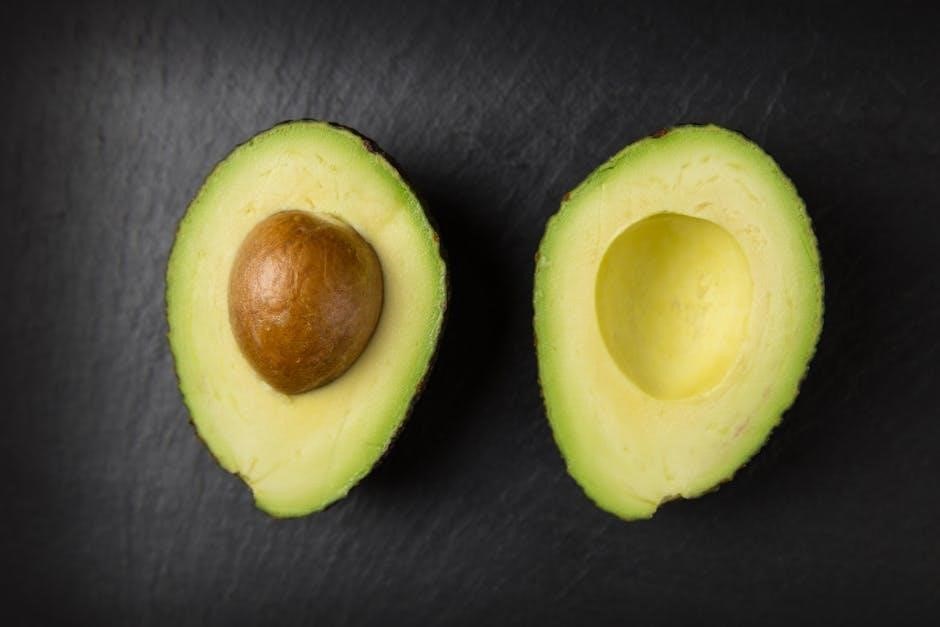
A low sulfur diet focuses on minimizing sulfur intake to support digestive health and reduce symptoms linked to sulfur sensitivity․ It emphasizes balanced nutrition while reducing sulfur-rich foods, promoting a natural approach to managing certain health conditions․
1․1 What is a Low Sulfur Diet?
A low sulfur diet is a dietary approach that focuses on reducing the intake of sulfur-containing foods to alleviate digestive discomfort, inflammation, or sensitivity․ It involves limiting foods like cruciferous vegetables, allium vegetables, high-sulfur meats, dairy products, and processed foods with added sulfites․ This diet is often adopted to manage conditions associated with sulfur sensitivity or metabolic issues, providing a structured plan to minimize symptoms and promote overall well-being through tailored nutrition․
1․2 Importance of Sulfur in the Body
Sulfur is an essential element in the human body, playing a critical role in various bodily functions․ It is a key component of amino acids, such as cysteine and methionine, which are vital for protein synthesis․ Sulfur supports detoxification processes, helps produce antioxidants like glutathione, and is involved in the maintenance of healthy skin, hair, and nails․ Additionally, it contributes to joint health by supporting cartilage formation․ While sulfur is necessary for optimal health, excessive intake can lead to discomfort in sensitive individuals, making moderation important for some․
1․3 Why Adopt a Low Sulfur Diet?
A low sulfur diet is often adopted to alleviate digestive discomfort, reduce inflammation, and manage conditions like sulfur sensitivity or intolerance․ By limiting sulfur-rich foods, individuals can minimize symptoms such as bloating, gas, and skin issues․ This dietary approach is particularly beneficial for those with digestive disorders or impaired sulfur metabolism․ Additionally, it may help reduce body odor and support overall gut health․ Adopting this diet requires careful planning to ensure nutrient balance while addressing specific health needs․
Core Principles of a Low Sulfur Diet
The core principles involve identifying high-sulfur foods, understanding their sulfur content, and balancing essential nutrients while minimizing sulfur intake to support health and reduce discomfort․
2․1 Identifying High-Sulfur Foods
Identifying high-sulfur foods is crucial for managing sulfur intake․ These include cruciferous vegetables like broccoli and cauliflower, allium vegetables such as garlic and onions, and certain meats like beef and lamb․ Dairy products, especially cheese, and processed foods with sulfur additives also fall into this category․ Recognizing these foods helps individuals make informed choices to reduce sulfur consumption effectively without compromising nutritional balance․
2․2 Understanding Sulfur Content in Foods
Understanding sulfur content in foods is essential for managing intake․ Sulfur occurs naturally in foods like meats, fish, dairy, and certain vegetables․ Processed foods may contain added sulfur compounds․ Knowing sulfur levels helps individuals make informed dietary choices․ Some foods, such as garlic and onions, are inherently high in sulfur, while others, like grains, are lower․ This knowledge aids in balancing meals and ensuring nutritional needs are met while adhering to a low-sulfur plan․ Awareness of sulfur content supports better meal planning and health management․

2․3 Balancing Nutrients on a Low Sulfur Diet
balancing nutrients on a low sulfur diet requires careful planning to ensure adequate intake of essential vitamins, minerals, and fiber․ consulting a nutritionist can help create a well-rounded meal plan that prioritizes nutrient-dense foods while minimizing sulfur content․ focusing on a variety of low-sulfur options maintains overall health and prevents deficiencies․ regular monitoring of nutrient levels helps tailor the diet effectively, ensuring all nutritional needs are met without compromising health benefits․

High-Sulfur Foods to Avoid
A low sulfur diet requires avoiding foods rich in sulfur, such as cruciferous vegetables, allium vegetables, high-sulfur meats, dairy, and processed foods containing sulfur additives․
3․1 Cruciferous Vegetables
Cruciferous vegetables, such as broccoli, cauliflower, kale, and Brussels sprouts, are among the highest in sulfur․ These vegetables contain sulfur-containing compounds like glucosinolates, which can exacerbate sulfur sensitivity in some individuals․ While they offer numerous health benefits, reducing their consumption is often necessary on a low sulfur diet․ It’s important to identify and limit these foods to manage sulfur intake effectively, especially for those with specific dietary needs or conditions related to sulfur metabolism․
3․2 Allium Vegetables
Allium vegetables, including garlic, onions, leeks, and chives, are high in sulfur compounds․ These compounds, particularly sulfur amino acids, can contribute to sulfur sensitivity and digestive discomfort in some individuals․ While they add flavor and nutrients to meals, reducing their consumption is often recommended on a low sulfur diet․ This is especially important for those managing conditions like sulfur intolerance or gut health issues, where high sulfur intake may exacerbate symptoms․
3․3 High-Sulfur Meats
High-sulfur meats, such as beef, pork, and lamb, contain significant amounts of sulfur due to their protein and amino acid composition․ These meats are metabolized into sulfur-containing compounds, which can worsen sulfur sensitivity or digestive issues in some individuals․ Reducing consumption of high-sulfur meats is often advised on a low sulfur diet to minimize potential discomfort․ Opting for leaner or plant-based protein sources can help lower overall sulfur intake while maintaining nutritional balance․
3․4 Dairy Products
Dairy products, such as milk, cheese, and yogurt, naturally contain sulfur due to their protein and amino acid content․ These foods can contribute to sulfur intake, potentially exacerbating sensitivity or digestive discomfort in some individuals․ Reducing or avoiding high-sulfur dairy products is often recommended on a low sulfur diet․ Opting for plant-based or low-sulfur alternatives, such as almond milk or rice-based products, can help minimize sulfur consumption while still providing essential nutrients․
3․5 Processed Foods Containing Sulfur
Processed foods often contain added sulfur compounds, such as sulfites, used as preservatives to extend shelf life․ These foods, including frozen meals, snacks, and fast food, can significantly increase sulfur intake․ Limiting or avoiding these products is crucial on a low sulfur diet․ Always check food labels for sulfites or sulfur-based additives․ Opting for whole, unprocessed foods helps minimize sulfur consumption and supports overall health․
Low-Sulfur Food Options
A low-sulfur diet emphasizes whole, nutrient-rich foods like fruits, vegetables, whole grains, lean proteins, and healthy fats․ These options support digestion and reduce sulfur-related discomfort․
4․1 Low-Sulfur Fruits
Low-sulfur fruits are an excellent choice for those adhering to a low-sulfur diet․ Options like bananas, berries, and citrus fruits are naturally low in sulfur․ These fruits provide essential vitamins, minerals, and antioxidants while minimizing sulfur intake․ Incorporating them into meals and snacks can help improve digestion and reduce sulfur-related discomfort․ Additionally, they offer natural sugars for energy and are typically easy to digest, making them a great addition to a balanced low-sulfur dietary plan․
4․2 Low-Sulfur Vegetables
Low-sulfur vegetables are a cornerstone of a balanced low-sulfur diet․ Options like leafy greens such as spinach and kale, as well as cucumbers, bell peppers, and zucchini, are excellent choices․ These vegetables are rich in nutrients but contain minimal sulfur, making them ideal for reducing sulfur intake․ Incorporating these vegetables into meals can support overall health while helping to manage sulfur-related sensitivities or digestive issues․ They are versatile and can be prepared in a variety of ways to suit different dietary preferences and needs․
4․3 Whole Grains
Whole grains are a nutritious and sulfur-friendly addition to a low-sulfur diet․ Options like brown rice, quinoa, and oats are rich in fiber, vitamins, and minerals․ They provide sustained energy and support digestive health without contributing significant sulfur․ Incorporating whole grains helps maintain balanced nutrition while adhering to a low-sulfur regimen․ These foods are versatile and can be paired with various low-sulfur ingredients to create satisfying and healthy meals․ They are an excellent choice for those seeking to optimize their diet for better overall well-being․
4․4 Healthy Fats
Healthy fats are essential for a balanced low-sulfur diet, providing energy and supporting nutrient absorption․ Avocados, nuts like almonds and walnuts, and seeds such as flax and chia are excellent choices․ Olive oil and coconut oil are also sulfur-friendly and can enhance meal flavors․ These fats promote heart health and reduce inflammation․ Incorporating them into meals adds variety and ensures a nutrient-rich diet while maintaining low sulfur intake․ They are versatile and can be used in cooking or as dressings for low-sulfur dishes․
4․5 Low-Sulfur Protein Sources
Low-sulfur protein sources are crucial for maintaining muscle health and overall nutrition․ Chicken, turkey, and fish like salmon or cod are excellent low-sulfur options․ Eggs are another versatile choice, rich in essential amino acids․ Plant-based options include tofu, lentils, and chickpeas, which are naturally low in sulfur․ These proteins provide balanced nutrition without overloading the body with sulfur, making them ideal for a low-sulfur diet․ Incorporating these options ensures adequate protein intake while adhering to dietary restrictions;

Health Benefits of a Low Sulfur Diet
A low sulfur diet can enhance overall well-being by reducing digestive discomfort, improving energy levels, and supporting skin health, making it a beneficial choice for many individuals․
5․1 Improved Digestion
A low sulfur diet can significantly improve digestion by reducing bloating, gas, and discomfort․ Lower sulfur intake decreases the production of sulfur-containing compounds during digestion, which can irritate the gut․ This approach is particularly beneficial for individuals with sensitive stomachs or conditions like irritable bowel syndrome (IBS)․ By limiting foods that are high in sulfur, such as cruciferous vegetables and certain meats, the digestive system experiences less strain, leading to smoother digestion and fewer digestive disorders․ This makes it easier to maintain a balanced and comfortable digestive health routine․
5․2 Reduced Inflammation
A low sulfur diet can help reduce inflammation by minimizing the intake of sulfur-containing compounds that may trigger or exacerbate inflammatory responses․ High sulfur foods can sometimes disrupt the balance of the gut microbiome, leading to increased inflammation in sensitive individuals․ By reducing sulfur intake, the body may experience less irritation and inflammation, particularly in conditions like arthritis or chronic inflammation․ This dietary approach supports a more balanced gut environment, potentially alleviating inflammatory symptoms naturally without relying on medication․
5․3 Management of Sulfur Sensitivity
A low sulfur diet is particularly beneficial for individuals with sulfur sensitivity, helping to manage symptoms such as bloating, gas, and digestive discomfort․ By identifying and reducing intake of sulfur-rich foods, the diet minimizes triggers that can exacerbate sensitivity․ This approach allows individuals to better control their symptoms and improve overall comfort․ Regular monitoring and gradual adjustments to the diet can further enhance its effectiveness in managing sulfur sensitivity long-term․
5․4 Enhanced Nutrient Absorption
A low sulfur diet can improve nutrient absorption by reducing sulfur’s interference with mineral uptake․ Sulfur compounds may inhibit the absorption of essential nutrients like iron, calcium, and zinc․ By limiting sulfur intake, the body can more efficiently absorb these minerals, supporting overall health and energy levels․ This dietary approach also promotes a balanced gut environment, further enhancing nutrient utilization․ As a result, individuals on a low sulfur diet often experience improved nutritional status and reduced deficiencies over time․

Challenges and Considerations
Adopting a low sulfur diet requires careful planning to avoid nutritional gaps․ It can be challenging to identify sulfur-rich foods and manage social eating situations effectively․
6․1 Limitations of a Low Sulfur Diet
A low sulfur diet may limit access to nutrient-rich foods, potentially leading to deficiencies in sulfur-containing amino acids and antioxidants․ It can also restrict dietary variety, making long-term adherence challenging․ Additionally, completely eliminating sulfur-rich foods may impact gut health and metabolic functions․ Balancing these limitations requires careful planning and professional guidance to ensure nutritional adequacy and overall well-being․
6․2 Ensuring Adequate Nutrition
Adhering to a low sulfur diet requires careful planning to maintain nutritional balance․ Consulting a dietitian can help avoid deficiencies in sulfur-containing amino acids, vitamins, and minerals․ Focus on alternative sources like low-sulfur proteins, fruits, and vegetables․ Incorporate a variety of nutrient-dense foods, including whole grains and healthy fats, to compensate for restricted options․ Regularly monitor nutrient levels and consider supplements if necessary to ensure overall health and well-being while following the diet․

6․3 Potential Impact on Gut Health
A low sulfur diet may affect gut health by altering the balance of sulfur-dependent gut bacteria․ While reducing sulfur can ease symptoms for some, it may also impact the production of beneficial sulfur-containing compounds, such as glutathione, which support gut lining integrity․ A gradual transition and monitoring of digestive changes are recommended to minimize potential disruptions․ Consulting a healthcare provider can help manage these effects and ensure a balanced approach to gut health while adhering to the diet․

Sample Meal Plan for a Low Sulfur Diet
Discover a structured, 7-day meal plan designed to help you transition to a low-sulfur lifestyle․ Explore delicious, sulfur-friendly recipes and balanced meal ideas for every day․
7․1 Breakfast Options
Start your day with low-sulfur breakfast ideas like oatmeal with fresh berries, smoothies made with low-sulfur fruits, or whole-grain toast topped with avocado or almond butter․ Avoid high-sulfur foods such as eggs, garlic-infused dishes, or cheese․ Opt for fresh fruit salads with apples, bananas, or pears, or try gluten-free pancakes made with almond flour․ These options are gentle on digestion and align with a low-sulfur lifestyle, ensuring a nutritious and balanced start to your morning․
7․2 Lunch Ideas
For a satisfying low-sulfur lunch, consider fresh vegetable salads with spinach, cucumbers, and bell peppers, paired with lean proteins like grilled chicken or tofu․ Whole grain wraps or brown rice bowls with avocado and olive oil are excellent options․ Avoid high-sulfur ingredients like cheese, eggs, and processed meats․ Try a vegetable stir-fry with zucchini, carrots, and herbs for flavor․ These meals are balanced, nutrient-rich, and align with a low-sulfur lifestyle, ensuring you stay energized and focused throughout the day․
7․3 Dinner Recipes
For a low-sulfur dinner, try grilled salmon with steamed zucchini and yellow squash, seasoned with herbs like parsley and dill․ Another option is a vegetable medley of bell peppers, carrots, and green beans sautéed in olive oil․ Quinoa or brown rice can accompany these dishes for a balanced meal․ Sweet potato mash with a drizzle of olive oil and a sprinkle of cinnamon is also a delicious choice․ These recipes are nutritious, sulfur-conscious, and flavorful, ensuring a satisfying evening meal․
7․4 Snack Suggestions
Low-sulfur snacks include fresh fruits like apples, pears, and bananas, which are naturally sulfur-free․ Veggie sticks such as cucumber, carrots, and celery are great options․ For protein-rich snacks, opt for small portions of nuts like macadamia or Brazil nuts․ Homemade trail mix with low-sulfur ingredients like dried berries and pumpkin seeds is also a tasty choice․ Rice cakes with a light spread of almond butter or coconut butter make for a satisfying snack․ Herbal teas or warm water with lemon can accompany these snacks for added hydration and digestion support․

Frequently Asked Questions
This section addresses common queries about the low sulfur diet, providing clarity on its benefits, challenges, and practical implementation for individuals considering this dietary approach․
8․1 Is a Low Sulfur Diet Suitable for Everyone?
A low sulfur diet is not suitable for everyone, as it depends on individual health needs and conditions․ While it can benefit those with sulfur sensitivity or specific digestive issues, others may not need to restrict sulfur intake․ Certain populations, such as those with high protein requirements or specific nutritional needs, should consult a healthcare provider before adopting this diet․ Its suitability varies based on health status, lifestyle, and sulfur tolerance․
8․2 Can I Still Eat Sulfur-Rich Foods in Moderation?
Yes, sulfur-rich foods can be consumed in moderation, depending on individual sensitivity and health goals․ For most people, occasional intake of sulfur-containing foods is unlikely to cause significant issues․ However, those with sulfur sensitivity or specific conditions may need stricter limits․ Portion control and monitoring symptoms are key․ Consulting a healthcare provider can help determine the best approach for balanced nutrition while managing sulfur intake effectively․ Moderation allows flexibility without compromising dietary needs․
8․3 How Long Should I Follow a Low Sulfur Diet?
The duration of a low sulfur diet depends on individual health needs and goals․ Some may adopt it short-term to alleviate symptoms like bloating or digestive discomfort, while others might follow it long-term to manage conditions like sulfur sensitivity․ Factors such as symptom improvement, overall health status, and dietary tolerance should guide the decision․ Consulting a healthcare provider can help determine the appropriate duration and ensure the diet remains beneficial without causing nutrient deficiencies over time․
8․4 Are There Any Risks Associated with a Low Sulfur Diet?
A low sulfur diet may pose risks if not properly balanced․ Sulfur plays a role in detoxification and antioxidant production, so excessive restriction could lead to nutrient deficiencies․ Potential risks include inadequate intake of sulfur-containing amino acids, which are crucial for protein synthesis and overall health․ Additionally, overly limiting sulfur-rich foods might reduce dietary variety, potentially impacting long-term nutritional adequacy․ It’s important to avoid eliminating entire food groups and consult a healthcare provider to ensure the diet remains safe and effective․
8․5 Where Can I Find More Resources on a Low Sulfur Diet?
For more resources on a low sulfur diet, consult healthcare providers or registered dietitians experienced in dietary restrictions․ Reputable websites like PubMed, the National Institute of Health, and nutrition-focused platforms offer evidence-based information․ Additionally, consider books on sulfur metabolism or digestive health, and explore online forums or support groups focused on low sulfur lifestyles․ Always verify information through credible sources to ensure accuracy and safety when making dietary changes․

Tracking Progress on a Low Sulfur Diet
Tracking progress involves monitoring symptoms, diet adherence, and health improvements․ Regularly assessing how your body responds helps tailor the diet for better outcomes and long-term success․
9․1 Keeping a Food Diary
A food diary is a powerful tool for tracking progress on a low sulfur diet․ By recording daily meals, snacks, and beverages, individuals can monitor sulfur intake and identify patterns․ Note the portion sizes, ingredients, and any symptoms experienced․ This helps pinpoint sulfur triggers and assess dietary adherence․ Regularly reviewing the diary can reveal trends and areas for improvement, ensuring the diet remains effective․ It also fosters accountability and awareness, crucial for long-term success and better health outcomes․
9․2 Monitoring Sulfur Intake
Monitoring sulfur intake is crucial for the effectiveness of a low sulfur diet․ Use a food diary to track daily consumption and ensure compliance with dietary goals․ Utilize online databases or nutrient apps to verify sulfur content in foods․ Regularly review meals to avoid high-sulfur ingredients and assess overall intake․ This proactive approach helps maintain adherence and prevents unintentional consumption of sulfur-rich foods, supporting optimal health outcomes and symptom management․ Consistent monitoring fosters greater awareness and control over dietary choices․

9․3 Regular Health Check-Ups
Regular health check-ups are essential while following a low sulfur diet to monitor progress and ensure overall well-being․ These visits allow healthcare providers to assess nutrient levels, track sulfur intake, and evaluate any potential deficiencies․ Blood tests and physical exams can help identify adjustments needed in the diet․ Regular check-ups also provide an opportunity to address concerns and prevent complications․ By maintaining consistent medical oversight, individuals can optimize their health outcomes and ensure the diet remains beneficial and sustainable in the long term․
Adopting a low sulfur diet can improve overall health and digestion when done correctly․ It requires careful planning to ensure nutrient balance and avoid deficiencies․ Consulting a healthcare provider before starting is crucial to tailor the diet to individual needs and goals․
10․1 Summary of Key Points
A low sulfur diet focuses on reducing sulfur-rich foods to alleviate digestive issues and inflammation․ It emphasizes balanced nutrition, avoiding high-sulfur foods like cruciferous vegetables and processed meats․ Benefits include improved digestion, reduced inflammation, and better nutrient absorption․ However, it requires careful planning to maintain adequate nutrition and avoid deficiencies․ Consulting a healthcare provider is essential to tailor the diet to individual needs and health conditions․ Regular monitoring and adjustments ensure long-term success and overall well-being․
10․2 Final Thoughts on Adopting a Low Sulfur Diet
Adopting a low sulfur diet can be a transformative approach for those experiencing sulfur-related sensitivities or digestive discomfort․ While it requires careful planning, the potential benefits of reduced inflammation, improved digestion, and enhanced nutrient absorption make it a worthwhile consideration․ It’s important to approach this diet with patience and professional guidance to ensure it aligns with your health goals and lifestyle․ With commitment and the right resources, a low sulfur diet can lead to improved well-being and long-term health outcomes․